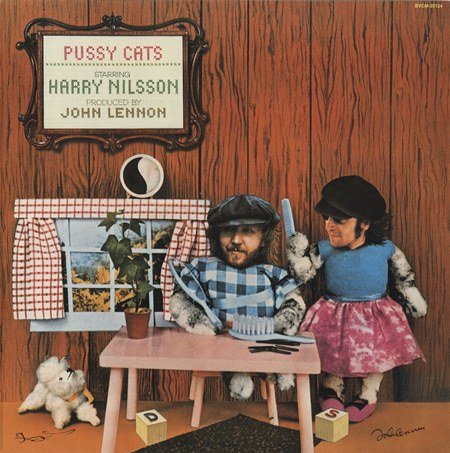
Harry Nilsson, Pussy Cats (RCA)
Blame it on the bottle, Harry Nilsson makes another phenomenal attempt to dismantle his own career. It had all been eccentric career moves and nonstop partying since “Without You” stunned the world and made him a star back in 1972. Bringing along ex-beatles John and Ringo (sometimes George and Paul stopped by as well) and a trail of thirsty celebrities (like Keith Moon) as cheerleaders, wasn’t the smartest thing to do, at least according to his doctor and his record company. RCA probably thought their star had gone insane. I don’t think “Son Of Dracula” (1974) is Mariah Carey’s favorite album (or movie), to put it that way.
“Pussy Cats” was born during John Lennon’s 18-month “lost weekend” in Los Angeles. Out on his own he turned into your drinking buddy from hell, having a lot of catching up to do. John and Harry triggered each other in their drunken stupors, feeding the gossip press with marvelous scandals. In between fistfights, heckling and being thrown out of night cubs with a sanitary pad on his head, John offered to produce Harry’s next album. Not surprisingly it turned into an open doors session, party time, drinks and drugs and a gallery of famous people who stopped by for a piece of the madness. Now and then they even created some music. In 1974 it was definitely not advisable to place Harry Nilsson, Keith Moon and Ringo Starr in the same room.
Lennon woke up during the chaos and realized that things were getting out of hand big time. So he brought the tapes and a very jagged Nilsson with him to New York to regain focus. It must have worried him that Nilsson’s voice sounded broken, but they probably didn’t discuss it. Actually it was more serious than John was aware of: Harry had ruptured one of his vocal cords during all the partying, but he didn’t dare to tell John.
Is “Pussy Cats” an underrated classic? Not at all. John Lennon was not a great producer and most of the songs suffer from his trademark narrow and clattering soundscape, his Phil Spector light. The content is eccentric, not unexpectedly. There are only four Nilsson originals (not among his most remarkable, except the beautiful “Black Sails”, a real treat), and one Lennon/Nilsson joint effort called “Mucho Mungo/Mt. Elga”, which simply is disposable nonsense.
As for the five cover songs, there is no telling why they were chosen. Could be rejects from Lennon’s own “Rock’n’Roll”-project. However they weaken rather that strengthen the album. They turn “Pussy Cats” into a little of this and a little of that instead of making it sound like a coherent record.
“Subterranean Homesick Blues” is absolutely horrible; the lyrics are drowned in the noise, a complete misjudgement as the lyrics are the reason for this very song’s existence. Then there’s an utterly botched and clattered “Rock Around The Clock” (Keltner, Ringo and Moon on drums, and still, what a mess!). Surprisingly the version of “Save The Last Dance For Me” is marvellous, Nilsson injects so much passion into those simple words that it sounds like the end of the world.
Lennon could have bettered the album some by replacing a couple of the covers with Nilsson’s own “Down By The Sea” and “The Flying Saucer Song”. Both songs were recorded during the sessions, but ended up as rejects (Nilsson re-recorded them later for “Duit On Mon Dei” (1975) and “Sandman” in 1976.
“Pussy Cats” was no big seller. And thus Nilsson’s time as a pop star was brought to an end. He got his voice back and recorded a number of outstanding albums later, but unfortunately they headed for the cut-out bins as soon as they were released.
As an artefact from a period in the history of rock when the heroes of the 60’s got a premature taste of midlife crisis and went temporarily bonkers, “Pussy Cats” works well. It is far better than Keith Moon’s “Two Sides Of The Moon”, holds its own compared to Ringo’s “Goodnight Vienna”, and there indeed is an affinity between “Pussy Cats” and Lennon’s “Walls And Bridges”.
None of the artists created their best work during this period. It was party time for desperate grown-ups behaving like college boys with too much money on their hands, living on a diet of dope and alcohol. They even recorded some music when they found time for it (and were able to stand up). The record sleeve of “Pussy Cats” says it all, telling its inside joke with a sledgehammer. Check out the floor under the table in the doll’s house: D + rug + S = DRUGS. Giggle, giggle, aren’t we crazy!
Released: August 19, 1974
Produced by: John Lennon.
Contents: Many Rivers to Cross/Subterranean Homesick Blues/Don’t Forget Me/All My Life/Old Forgotten Soldier/Save the Last Dance for Me/Mucho Mungo/Mt. Elga/Loop De Loop/Black Sails/Rock Around the Clock
The cast of thousands:
Nathalie Altman – Choir, Chorus, Children’s Chorus
Kenny Ascher – Piano, Conductor, Orchestration
Susie Bell – Choir, Chorus, Children’s Chorus
Gene Cipriano – Saxophone
Jesse Ed Davis – Guitar
Chuck Findley – Trombone
Troy Germano – Choir, Chorus, Children’s Chorus
Jane Getz – Piano
Jim Horn – Saxophone
Jim Keltner – Drums
Bobby Keys – Saxophone
Sneaky Pete Kleinow – Pedal Steel
Danny Kortchmar – Guitar
Trevor Lawrence – Saxophone
Keith Moon – Conga, Drums, Wood Block
Erik Mueller – Choir, Chorus, Children’s Chorus
Rachel Mueller – Choir, Chorus, Children’s Chorus
Harry Nilsson – Piano, Piano (Electric), Vocals, Performer, Author, Adaptation
Phylida Paterson – Choir, Chorus, Children’s Chorus
Peri Prestopino – Choir, Chorus, Children’s Chorus
Willie “The Lion” Smith – Organ
Ringo Starr – Drums, Maracas
David Steinberg – Choir, Chorus, Children’s Chorus
Cantey Turner – Choir, Chorus, Children’s Chorus
Kristin Turner – Choir, Chorus, Children’s Chorus
Damon Vigiano – Choir, Chorus, Children’s Chorus
Klaus Voormann – Bass
Cynthia Webb – Marimba
 |
 |
 |





